The internet of things (IoT) has ushered in a new era of connectivity, intelligence, and efficiency for businesses. Staying ahead of IoT trends provides an array of benefits, from increased operational efficiency and improved customer experiences to better decision-making and new avenues of revenue generation.
To leverage this transformative force, keeping up with emerging IoT trends is imperative. However, finding these key trends across a plethora of reports and online sources can be challenging. That’s why we’ve used our expertise at Business2Community to deliver the latest IoT trends for 2025, ensuring you have the insights to reap significant benefits for your business.
Key IoT Trends
- There will be over 16.7 billion connected IoT devices in 2023, increasing to over 55.7 billion devices in 2025.
- The economic impact of IoT could reach $12.5 trillion by 2030.
- By 2025, 75% of all IoT data collection and processing will occur outside of cloud data centers.
- Consumer spending on smart home products and services is expected to jump to more than $170 billion by 2025.
- 75% of businesses have made IoT device security a priority.
What are 2025’s IoT Trends?
According to an IoT Analytics report, the number of connected IoT devices has increased by 16% to 16.7 billion in 2023. Meanwhile, the global IoT market, which has shown significant growth over the last few years, is poised to grow from $478.36 billion in 2022 to $2.4 trillion by 2029.
The potential economic value of IoT is massive; McKinsey estimates that the economic impact of IoT including the value captured by consumers and customers of IoT products and services could reach $12.5 trillion by 2030.
IoT’s potential economic value will be realized through the following use cases:
- Operations optimization – 41%
- Health – 15%
- Human productivity – 15%
- Condition-based maintenance – 12%
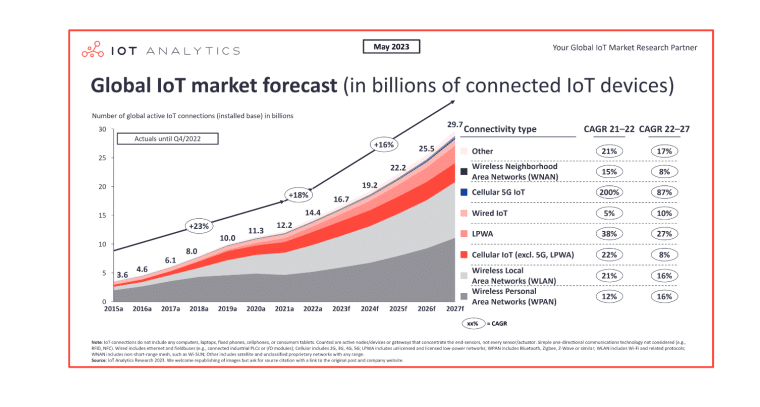
- In manufacturing settings, IoT could achieve up to a 10% to 15% reduction in operating costs, including a 5% to 10% cut in spending on energy.
- In agricultural settings, IoT technologies could improve yield between 15% and 20%.
- In health settings, IoT use cases could have a 6% to 10% impact on the disease burden.
- In construction settings, IoT can increase throughput by 5% to 10% percent, reduce raw material cost by 5% to 9%, and improve employee efficiency by 7% to 15%.
- In retail settings, IoT-enabled personalized promotions can increase in-store consumer spending by 20% to 30%.
To reap the above benefits and more, some of the top IoT trends to embrace in 2023 and beyond include: AI, 5G, edge computing, and digital twins. Let’s explore them in greater detail below.
1. Edge Computing Enhances IoT Capabilities
The rapid advancements in IoT technology have led to a surge in connected devices across various industries.
As these smart devices generate massive volumes of data, they put pressure on existing network and infrastructure capabilities. Edge computing has emerged as a promising solution to this challenge.
Edge computing refers to distributed systems that bring data storage and processing closer to IoT or edge devices, eliminating the need for centralized cloud servers or data centers.
Gartner has predicted that by 2025, 75% of all data collection and processing will occur outside of cloud data centers, an increase of 65% from 2018. This will provide businesses benefits such as:
- Reduced latency
- Real-time data processing and analysis
- Real-time insights
- Improved decision-making
- Device energy efficiency
- Lower bandwidth requirements
- More resilient and scalable systems
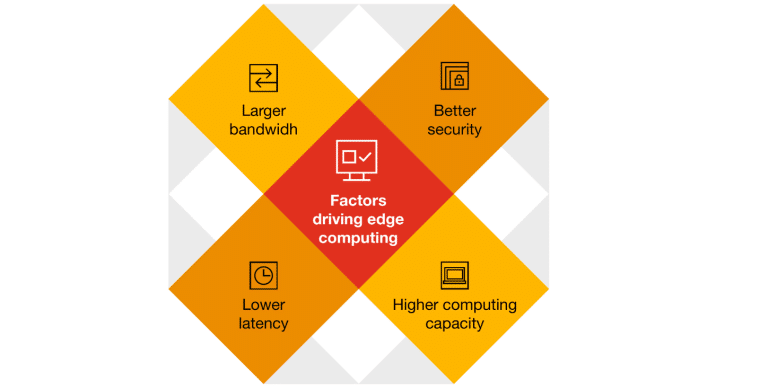
In addition, edge computing enhances data privacy and security by:
- Processing sensitive information locally.
- Reducing the attack surface.
- Enabling real-time threat detection.
- Facilitating network segmentation.
- Complementing traditional security measures.
- Providing scalability and flexibility in IoT deployments.
In fact, in 2021 Gartner predicted that organizations adopting edge architecture to isolate and segment their networks would experience a 25% reduction in successful cyberattacks.
As businesses seek new sources of value, edge computing is expected to be a key enabler of data-intensive applications. According to the IDC, global enterprise and service provider spending on edge computing is expected to hit $208 billion in 2023, an increase of 13.1% over 2022. By 2026, spending will reach nearly $317 billion.

According to KPMG, the five industries forecasted to experience impressive growth due to the intersection of IoT, 5G, and edge computing include:
- Industrial manufacturing
- Environmental monitoring
- Gaming
- Connected healthcare
- Intelligent transportation
The total addressable revenue in these five industry use cases is expected to increase from $361 billion in 2019 to over $517 billion in 2023.
Overall, the edge computing market is expected to grow at a CAGR of 15.6% from $13.49 billion in 2023 to $27.85 billion by 2028.
2. AI and IoT Converge
According to IDC, the number of connected devices is expected to reach 55.7 billion by 2025, generating over 80 zettabytes (ZB) of data per year.
These massive data streams cannot be processed and analyzed by humans alone. Fortunately, artificial intelligence marks a significant turning point. The convergence of IoT innovation, AI, and machine learning (ML) – known as the artificial intelligence of things (AIoT) – is set to revolutionize IoT data analysis capabilities.
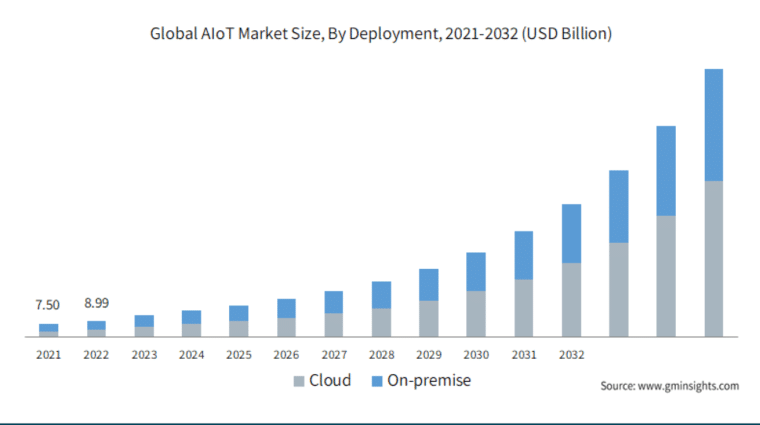
With a valuation surpassing $9 billion in 2022 and a projected CAGR of 20% from 2023 to 2032, the AIoT market will unlock the following benefits in various industries:
- AI algorithms will help process data and conduct complex data analysis to provide real-time data, identify patterns, and provide valuable business insights.
- IoT devices will be able to learn from user behavior, adapt to preferences, automate processes, and make predictive suggestions.
- AI will increase the efficiency and accuracy of IoT applications, increasing IoT adoption across industries to solve real business problems more effectively than traditional methods.
AIoT and Healthcare
Among the key industries set to benefit from AIoT is the healthcare sector. As AIoT gains momentum in the healthcare industry, the AIoT in the healthcare market is set to experience a CAGR of over 25% between 2023 and 2032.
The integration of AI into the internet of medical things (IoMT) will revolutionize the healthcare industry by enabling:
- Real-time patient data access
- Remote patient monitoring
- Improved patient care
- Optimized resource management
- Lower healthcare costs
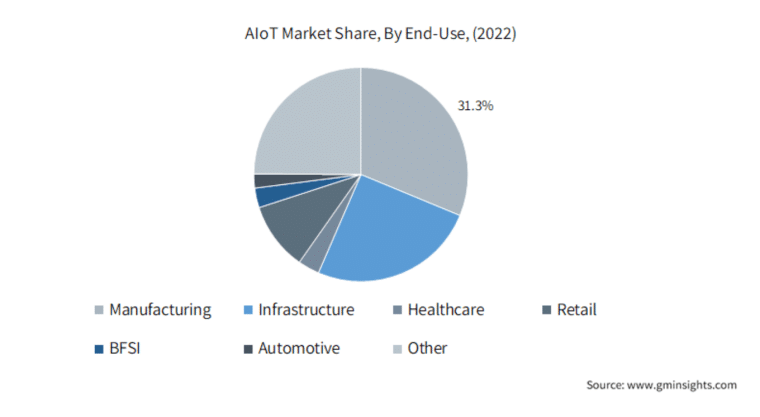
AIoT and Smart Cities
With the share of the world’s population living in cities expected to increase from 55% to 80% by 2050, this presents a myriad of challenges and requires urgent action to make urban environments safer and more efficient. Part of the solution will come from the development of smart cities.
These cities will leverage AIoT to:
- Enhance infrastructure, transportation, waste management, and public safety.
- Optimize energy consumption, reduce waste, and promote sustainable living.
- Enable smart traffic management, smart parking, and smart energy management.
- Improve security systems and emergency services.
Global technology spending on smart cities is expected to increase from $81 billion in 2018 to $189.5 billion in 2023 as more cities turn to AIoT to connect as well as manage utilities, parking meters, traffic lights, and more.
3. 5G Drives IoT Growth
5G has gained widespread adoption and coverage in 47 of the world’s 70 largest economies by GDP. The global 5G IoT market is expected to hit $89.42 billion by 2030, at a CAGR of 50.2% between 2023 and 2030.
In addition, the number of IoT sensors running on 5G networks is expected to surge from around 17 million to over 116 million by 2026. The growth spike will come as the healthcare sector and smart cities stimulate the adoption of 5G-based IoT solutions.
On the other hand, IoT devices connected via 2G and 3G are forecasted to have a negative annual growth rate of around 20% up to 2028, as the rate of switch-off for both technologies will continue to increase in the coming years.
According to a CTIA report, 5G supports IoT networks by providing:
- Speeds up to 100x faster.
- A 10x decrease in latency or the delay that occurs when data is transmitted across distances.
- 100x the traffic capacity, enabling dense deployments of connected devices.
- 5x more responsiveness.
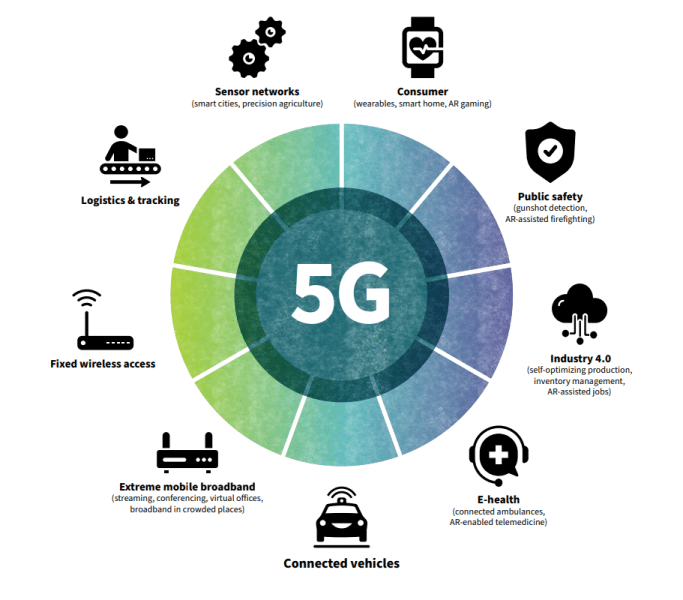
Since 2018, US providers have invested over $121 billion in designing and deploying 5G networks to facilitate new use cases. This investment is expected to create $1.5 trillion in economic growth and 4.5 million new jobs in the US over the next decade.
Globally, IDC expects investment in the IoT ecosystem to surpass $1 trillion in 2026 with a CAGR of 10.4% between 2023 and 2027. Additionally, worldwide spending on IoT is expected to reach $805.7 billion in 2023, an increase of 10.6% over 2022.
These developments are set to drive growth and innovation in the IoT industry, paving the way for new applications and services in various sectors.
4. Consumer IoT is Poised for Steady Growth
Consumer IoT, which is connecting everyday objects like smart home devices, wearable devices, and connected vehicles, is poised for steady growth.
From smart thermostats to voice-based user interfaces like Amazon Alexa, consumers are embracing the convenience and control that smart home technology offers.
Consumer spending on smart home products and services is expected to jump to more than $170 billion by 2025. By then, number of households with smart home systems is expected to exceed 400 million globally.
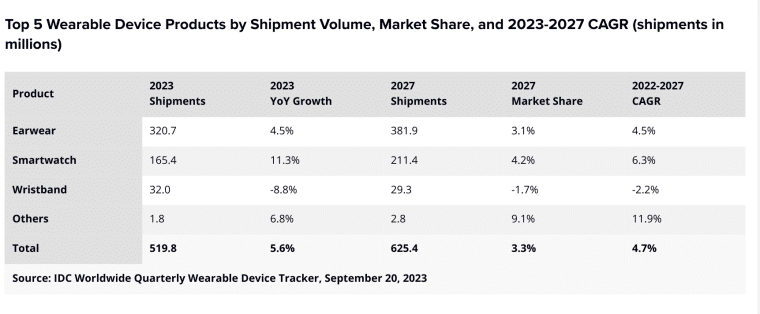
Meanwhile, IDC forecasted 520 million wearables will be shipped in 2023, up 5.6% from 2022. Hearables are the top category accounting for 62% of shipments, followed by smartwatches with nearly 32%.
Looking ahead, the wearable technology market is expected to grow to $625.4 million by the end of 2027, representing a 4.7% CAGR.
The interest in IoT devices presents a massive opportunity for businesses, with projected revenue in the global IoT market estimated to reach an impressive $183 billion by 2023 and $231 billion by 2028.
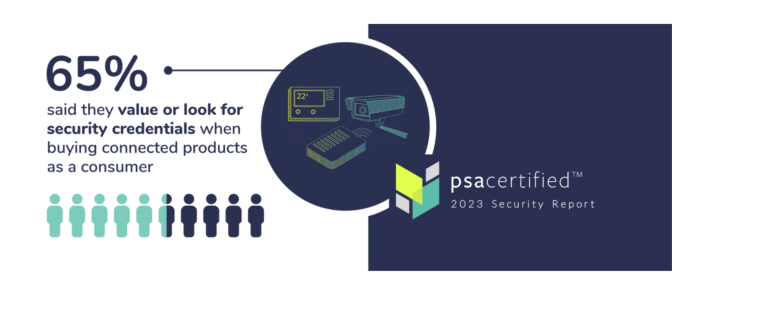
However, as the number of IoT devices increases, so have consumer concerns about cyberattacks on their smart homes, healthcare, and fitness devices.
In a 2023 PSA Certified report, it was found:
- 70% of consumers say their security concerns have increased in the past year.
- 65% said they look for security credentials when they buy IoT products.
- 69% said they would pay a premium for products that have security built in.
In response, 75% of businesses have made device security a priority. A further 68% have welcomed increased regulation as a way to build consumer trust.
5. IoT Ushers in Industry 4.0
Industry 4.0 encompasses IoT and smart manufacturing, bringing together physical operations, smart digital technology, automation, machine learning, and big data to create interconnectivity. This provides access to real-time insights across processes, partners, vendors, products, and people.
In manufacturing, IIoT, or the industrial internet of things, creates smart factories equipped with sensors and devices to gather data, optimize processes, and mitigate potential problems.
IIoT technology represents a new era of Industry 4.0, powering devices that communicate and exchange data more efficiently, effectively, and at a larger scale. It enables optimized:
- Supply chain management
- Data analytics
- Predictive maintenance
- Asset tracking
This, in turn, increases productivity, improves processes, and drives growth.
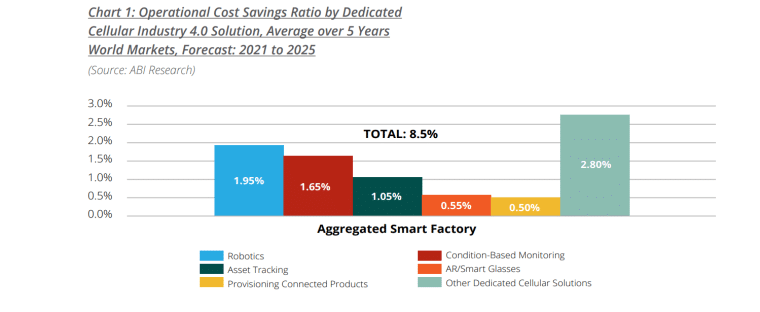
According to Statista, 72% of industrial organizations consider IoT the most important component of Industry 4.0.
Additionally, dedicated Industry 4.0 solutions with cellular connectivity through IoT devices can yield ROI ranging from 10x to 20x over a 5-year period, as per a 2023 ABI research report.
These solutions can also generate 8.5% in operational cost savings, which equates to $200 to $600 per sqm per year for a factory or industrial site.
Regarding specific technologies that integrate sensors, connectivity, and data analytics, the same report found that:
- Mobile robots such as autonomous guided vehicles (AGVs) and autonomous mobile robots (AMRs) which maximize staff coordination and prevent slow-downs, generated the highest operational cost savings of 1.95% of overall manufacturing total cost of ownership (TCO).
- Condition-based monitoring which improves maintenance schedules and prevents unplanned downtime, led to an operational cost savings of 1.65% of overall TCO.
- Asset tracking led to an operational cost savings of 1.05% of overall manufacturing TCO.
6. IoT Advances Digital Twin Technology
A digital twin is a virtual representation of a physical object, system, or process. Leveraging IoT data, digital twins can be used to monitor performance, predict potential problems, and optimize operations. This results in benefits such as:
- Improved decision-making
- Reduced downtime
- Increased productivity
- Enhanced customer satisfaction
Digital twins can also be used to simulate hacker attacks on IoT systems, allowing security experts to improve data protection.
As the number of IoT devices and sensors increases, so will the data needed to advance digital twin technology. The global digital twin market, valued at $11.5 billion in 2022, is expected to hit $137 billion by 2030.

29% of global manufacturing companies have either fully or partially implemented digital twin strategies. However, this technology’s potential extends far beyond manufacturing and is rapidly gaining traction in other industries.
In 2022, McKinsey highlighted that digital twins can accelerate the time to market for various applications and use cases as well as:
- Reduce time to deploy new AI-driven capabilities by up to 60%, allowing businesses to reap the benefits of AI more quickly.
- Reduce capital expenditures and operating expenditures by up to 15%, leading to significant cost savings.
- Enhance commercial efficiency by about 10%, boosting productivity and profitability.
By 2027, more than 90% of all IoT platforms will have digital twinning capability and Gartner has estimated that over 40% of global companies will leverage digital twins in their projects to increase revenue.
7. IoT Security Concerns Intensify
As businesses across different sectors adopt IoT to increase productivity, efficiency, and revenue, the IoT device market is expected to reach $1.6 trillion by 2025. This increase in IoT adoption will significantly increase organizations’ attack surface.
According to a 2023 Nozomi Networks report:
- Many vulnerabilities are still being found in IoT devices, with many classified as critical or easily exploitable.
- Healthcare, energy, and manufacturing remain top targets for ransomware attacks, causing significant disruption to organizations.
- Threat actors continue to employ opportunistic tactics, such as exploiting vulnerabilities, abusing credentials, and using phishing methods, to gain initial access, launch DDoS attacks, and execute trojans.
Sonicwall’s midyear 2023 report found that IoT malware attacks reached 77.9 million, up 37% year-over-year and higher than any other six-month period on record.
This total not only exceeds 2022’s midyear total by more than 20 million, it also exceeds the full-year total for both 2020 and 2021 and is more than 2018 and 2019 combined.
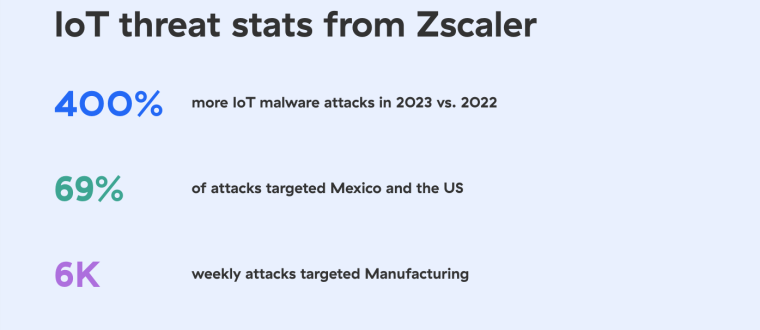
Zscaler also reported that IoT malware attacks were up 400% year-over-year and that there has been a massive 5x increase in IoT malware attacks involving over 350 attack payloads since 2022.
Amid a rapidly evolving threat landscape, 80% of qualified respondents in a 2023 Palo Alto Networks report viewed the implementation of either new or upgraded IoT security measures as a top 3 business initiative priority over the next 12 months.
As a result, the IoT security market is expanding for businesses that offer IoT security solutions. The market is expected to surge from $4.94 billion in 2023 to $20.98 billion by 2028, representing a notable CAGR of 33.53% between 2023 and 2028.
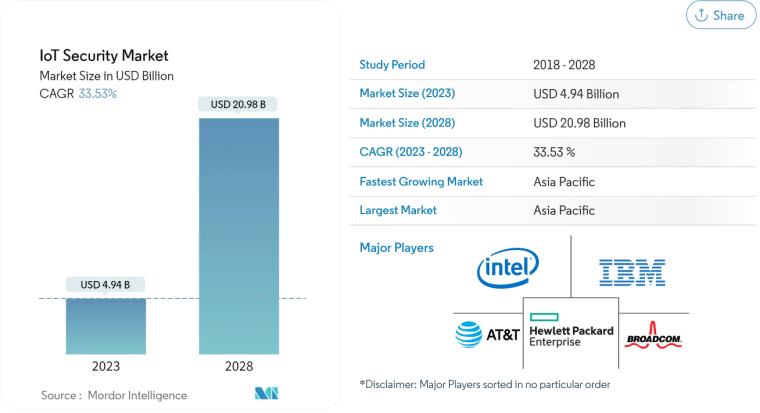
Businesses adopting IoT are advised to invest in emerging security solutions such as:
- Blockchain: Improves IoT security through advanced encryption, biometrics, and verification, safeguarding against cyber threats and privacy breaches. Its decentralized, tamper-proof ledger ensures data integrity and authenticity, addressing security and privacy concerns in IoT systems.
- Zero trust: Assumes no device or user should be trusted by default, even if they are connected within the organization’s network. Instead, every device and user must continuously prove their identity and authorization before being granted access to any resources or data.
- Network segmentation: By dividing a network into isolated segments, the impact of a security incident can be contained or limited, and unauthorized access can be easily detected and prevented.
- Machine learning for anomaly detection: Machine learning algorithms can be used to analyze patterns and detect anomalies in IoT data. By establishing a baseline of normal behavior, any deviations from this baseline can be flagged as potential security threats, allowing for swift action.
Businesses investing in IoT security can expect significant returns. A recent study by Gartner found that the average ROI for businesses implementing IoT security was 30% while those that didn’t invest in IoT security had an average negative return of minus 5.6%.
8. IoT Regulation and Security Measures Struggle to Keep Up
As dependence on connected devices continues to grow, so will risks and governance challenges in areas such as security, privacy, sustainability, and interoperability. NetGear reported in 2023 that governments and businesses are struggling to keep up with a rapidly evolving IoT threat landscape.
The same report reveals that vendors’ slow reaction to vulnerability disclosure and patching will persist throughout 2023. And while new regulations are anticipated to provide some relief by imposing mandatory cybersecurity standards for products, their enforcement is not expected until at least 2025.
Recent regulations in the US include:
- The National Cybersecurity Strategy and its subsequent implementation plan.
- The IoT Cybersecurity Improvement Act.
- New FDA legislation effective March 2023, requiring medical device manufacturers to take measures to include security by design or add cybersecurity protections to their products before they are brought to market.
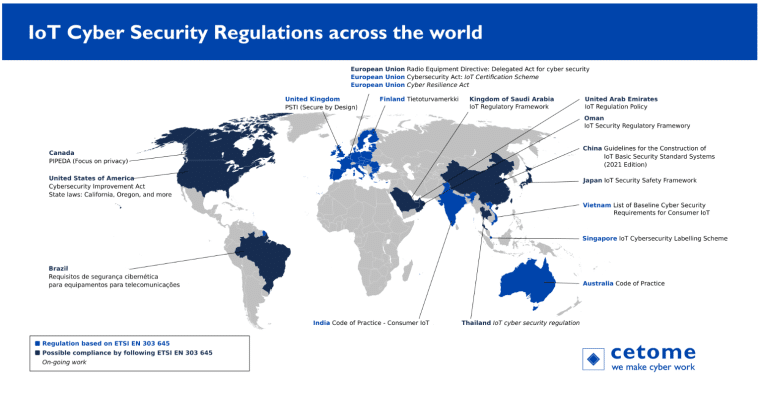
Governments around the world have also been working to enhance cybersecurity legislation and critical infrastructure policy, examples include:
- The EU NIS 2 Directive
- The EU Cybersecurity Act
- The Security of Critical Infrastructure Act in Australia
A majority of these laws require IoT device manufacturers to take measures to prevent malicious attacks and data breaches. However, businesses will also need to place greater emphasis on privacy and data security measures. These include:
- Protecting consumer data and privacy
- Encrypting data
- Anonymizing identifiers
- Obtaining user consent
- Complying with regulations such as GDPR and CCPA
Failure to do so may erode consumer trust, increase exposure to costly data breaches, or incur hefty GDPR fines of between 2% to 4% of annual revenue.
How to Find IoT Trends
Although we’ve provided key internet of things trends to watch for 2025 and beyond, it’s important to be able to find IoT trends as they become important. That’s why we’ve rounded up some of the best ways to keep up with IoT innovations and other related emerging technologies.
From authority sites and blogs to podcasts, newsletters, and YouTube channels, there are many well-established sources dedicated to the IoT sector. We explore a few below.
Authority Sites and Newsletters
Authority sources from across the web are a great way to keep up with what’s happening in the IoT space. These include:
- Deloitte’s IoT blog: Deloitte provides IoT-related consulting services and its IoT blog includes a mix of articles, case studies, analysis, and other insights.
- Gartner Insights on IoT: Gartner provides research for IT services, including IoT and its blog is a source for comprehensive reports on IoT technologies.
Newsletters such as IoT Business News’ semimonthly newsletter, can help you stay on the cutting edge of the IoT industry through curated updates on the latest trends, insights, and innovations.
Youtube Channels
To watch industry leaders, analysts and developers explore the latest trends and IoT technologies, subscribe to YouTube channels such as IoT Now. This channel offers global IoT news, interviews with experts, free webinars, and quickfire debates on trending topics.
Podcasts
To stay ahead of the curve, follow and listen to podcasts like IoT For All. This podcast brings together the smartest and most creative minds in the IoT industry, as they share their knowledge and expertise with the world. The podcast’s ultimate goal is to educate the world on the benefits and inner workings of the industry.
The Future of IoT
Future trends in IoT point to:
- Seamless, secure connectivity powered by technologies such as 5G and edge computing.
- AI-powered IoT analytics and security.
- Greater integration and applications across industries.
By 2030, 65% of IoT’s $12.5 trillion potential value will come from B2B applications. However, the value of B2C applications is expanding, spurred by faster-than-expected adoption of IoT solutions within the home.
In the coming years, the fragmented and siloed nature of current technology stacks, characterized by numerous walled gardens and proprietary systems, will pose a significant challenge. If businesses and consumers are to experience the full economic impact of IoT, interoperability is crucial.
